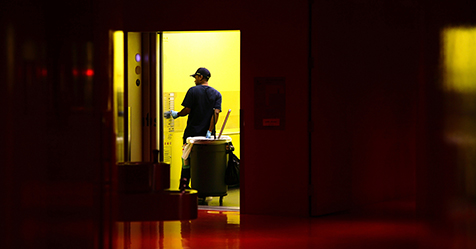In an evolving post-pandemic era, building owners, facility managers, and cleaning industry professionals must ask themselves four questions to clearly determine if they are properly cleaning facilities to protect occupant health and safety:
- Are we cleaning the right spaces in the facility?
- Are we cleaning the right surfaces in
those spaces? - Is the current frequency of cleaning sufficient?
- Are we cleaning effectively?
Historically, we have based cleaning performance on appearance, the subjective visual inspection of how the facility looks after cleaning. However, visual inspection has proven to have serious limitations because what looks clean may not be clean at all. Appearance has little to do with how effectively spaces and surfaces are cleaned, since it is the things we cannot see that can harm health. With this in mind, let’s answer these four questions to address cleaning performance.
1. Are we cleaning the right spaces in the facility?
Clearly, not all spaces in a facility are equal relative to the risk of transmitting pathogens and other harmful agents. Thus, begin by identifying all “space types” such as lobbies, breakrooms, offices, and restrooms. Identifying cleaning performance by specific space types will provide performance data that will help you identify cleaning issues within similar spaces. This will help you establish cleaning performance benchmarks for individual space types and allow you to focus resources on spaces that matter most from a risk-reduction perspective.
2. Are we cleaning the right surfaces in those spaces?
As some spaces within a building pose greater risk for pathogen transmission, so do certain surfaces within those spaces. For example, floors, walls, and ceilings pose lower risk of transmission when compared to surfaces touched by multiple people throughout the day. In a restroom, for instance, high-touch surfaces include metal door handles, faucet handles, toilet flush valves, stall handles/locks, and paper towel dispenser handles. High-touch spaces in an office include door handles, chair arms, working surfaces, keyboards and mouse devices, light switches, and comfort controls. Focusing cleaning attention on these high-touch/high-risk surfaces is critical for effectively protecting occupant health.
3. Is the current frequency of cleaning sufficient or excessive?
Many cleaning contracts require spaces to be cleaned once per day, but is this sufficient if multiple people are using the space, such as a conference room or breakroom, throughout the day? And if only one person uses a space each day, such as a private office or cubicle, is it necessary to clean this space daily? You can now use technology to efficiently, cost effectively, and objectively determine when and how often to clean to best protect occupant health.
4. Are we cleaning effectively?
Technology like adenosine triphosphate (ATP) meters can now answer this question objectively. Frequent testing with ATP meters allows us to not only evaluate cleaning performance, but also helps us improve cleaning effectiveness. These meters enable cleaning professionals to focus resources on those spaces and surfaces that are most important to protecting health while minimizing unnecessary cleaning, especially the overuse of disinfectants, which has become a significant issue due to the COVID-19 pandemic.




